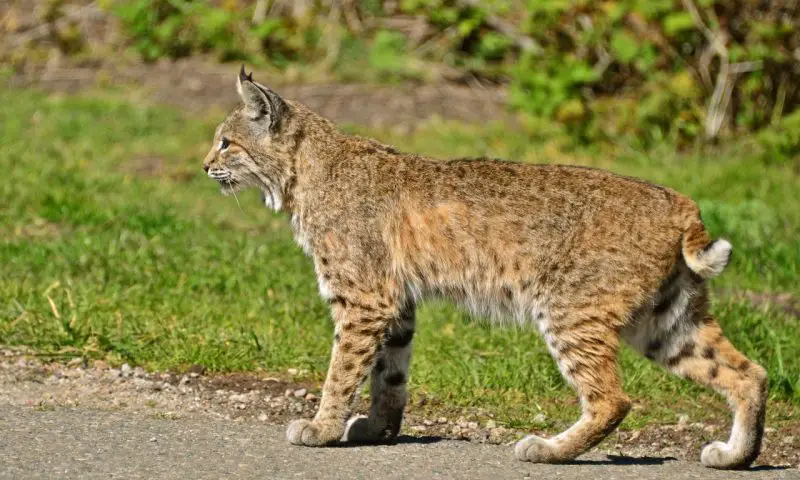Bobcats are elusive and fascinating predators native to North America. In Tennessee, these medium-sized felines play a crucial role in maintaining ecological balance, preying on rodents, rabbits, and other small mammals. Understanding the breeding season of bobcats in this region is essential for wildlife enthusiasts, researchers, and conservationists alike. Observing their reproductive patterns helps in population monitoring, habitat management, and in promoting coexistence with humans.
This article explores the typical breeding season of bobcats in Tennessee, their mating behaviors, gestation period, and the life cycle of their young, providing comprehensive insights into these secretive animals.
Understanding Bobcats in Tennessee

Bobcats (Lynx rufus) are adaptable creatures that thrive in a variety of habitats. In Tennessee, they can be found in forests, grasslands, and even in suburban areas where food sources are abundant. Recognizable by their short, “bobbed” tail, tufted ears, and distinctive spotted coat, bobcats are solitary and territorial animals. Males and females maintain overlapping home ranges, but interactions outside mating are minimal.
Tennessee’s diverse ecosystems provide an ideal environment for bobcats, offering shelter, prey, and access to water sources. Despite their adaptability, they are highly secretive, making direct observation challenging.
The bobcat’s solitary nature has implications for its reproductive behaviors. Unlike pack animals, bobcats do not exhibit complex social interactions. Mating occurs mainly as a response to hormonal cycles rather than social bonding. This independence allows researchers to focus on seasonal patterns to predict reproductive activity. Tennessee’s climate, with its mild winters and humid summers, influences the timing of breeding, gestation, and the survival of kittens.
The Timing of the Breeding Season
The typical breeding season for bobcats in Tennessee generally occurs from late winter to early spring, typically spanning from February through March. However, environmental factors such as food availability, climate, and population density can shift this period slightly.
Female bobcats, or queens, experience estrus, the phase of reproductive readiness, which usually lasts for several days. During this time, they emit vocalizations and scent markings to attract males, signaling their readiness to mate.
Males, or toms, respond to the presence of a female in estrus by temporarily expanding their home ranges and actively searching for mates. This period of heightened activity often makes bobcats more visible, though encounters with humans remain rare due to their elusive nature.
The synchronization of mating with late winter ensures that kittens are born in the spring when food availability increases, optimizing their chances of survival. Tennessee’s mild spring temperatures and abundant prey create favorable conditions for rearing young bobcats.
Mating Behavior and Rituals
Bobcat mating behavior is both intriguing and relatively straightforward due to their solitary lifestyles. Courtship is brief, involving vocalizations, scent marking, and short chases. Unlike social species, bobcats do not engage in prolonged pair bonding.
Males may compete for access to a female in estrus, sometimes engaging in aggressive encounters, but physical confrontations are usually avoided unless absolutely necessary. Once mating occurs, the male often leaves, and the female assumes full responsibility for raising the kittens.
During the breeding season, vocal communication is essential. Females use caterwauling, a series of yowls and calls, to signal readiness, while males respond with their own vocalizations to establish presence and dominance. Scent marking plays a dual role: it communicates reproductive status and reinforces territorial boundaries, reducing unnecessary conflicts between males. These behaviors highlight the importance of chemical and auditory signals in bobcat reproduction.
Gestation and Birth
After successful mating, female bobcats undergo a gestation period of approximately 60 to 70 days. During this time, the queen becomes increasingly reclusive, seeking sheltered dens in dense vegetation, rock crevices, or abandoned burrows. The choice of den site is critical for the safety of newborn kittens, providing protection from predators and harsh weather conditions.
In Tennessee, spring weather typically offers moderate temperatures and sufficient cover, allowing mothers to care for their young without significant environmental stress. Litter size generally ranges from one to four kittens, with two being the most common.
Kittens are born blind and helpless, relying entirely on their mother for warmth, nourishment, and protection. The early weeks of life are critical, as survival rates depend on maternal care and the availability of prey in the surrounding habitat. Observations in Tennessee indicate that the density of prey species such as rabbits and rodents directly influences kitten growth and survival.
Development and Early Life of Kittens
Bobcat kittens experience rapid development during their first few months. Eyes typically open around 10 days after birth, and fur begins to show distinct spotting patterns that aid in camouflage. By four weeks, kittens start exploring their immediate surroundings, learning essential survival skills through play and observation of their mother’s hunting techniques.
Tennessee’s natural environment provides ample opportunities for learning, with diverse terrains that mimic challenges encountered in adulthood. By eight to twelve weeks, kittens are weaned from their mother’s milk and begin consuming solid prey, initially small mammals and insects. Although still dependent on maternal guidance, they gradually develop independence.
The mother continues to provide protection and teaches hunting skills until the kittens are old enough to leave the den permanently. This period is crucial for building the foundation for future survival, as young bobcats must master stealth, hunting, and navigation within their home ranges.
Factors Influencing Breeding Season Variability
While the general breeding season for bobcats in Tennessee is relatively consistent, several factors can influence timing and reproductive success. Climate fluctuations, particularly harsh winters or unseasonably cold springs, may delay mating or reduce kitten survival. Prey availability is another critical factor; abundant food resources support healthier females and larger litters, whereas scarcity can lead to delayed estrus and reduced reproductive output.
Human activity also plays a role. Urban expansion, road networks, and habitat fragmentation can impact movement patterns, den site availability, and mating opportunities. Tennessee wildlife management programs monitor bobcat populations to understand these influences, ensuring that conservation strategies account for environmental and anthropogenic pressures. Adaptive management is essential for sustaining healthy bobcat populations in a rapidly changing landscape.
Conservation and Management Implications
Understanding the breeding season of bobcats in Tennessee has practical implications for conservation and wildlife management. Knowledge of reproductive cycles helps wildlife agencies plan hunting seasons, manage habitat, and implement protective measures during critical periods. Protecting den sites during the spring is particularly important to reduce mortality rates among vulnerable kittens.
Research on bobcat breeding patterns also informs population modeling and ecological studies. By tracking the timing of estrus, gestation, and kitten emergence, scientists can estimate population dynamics, reproductive success, and potential threats. Such data are vital for ensuring sustainable coexistence between humans and bobcats, particularly in regions where habitat overlap is significant.
Observing Bobcats Responsibly
For wildlife enthusiasts interested in observing bobcats during the breeding season, patience and discretion are essential. Direct interaction should be avoided, especially near dens, to prevent stress or abandonment of kittens. Tennessee’s state parks and wildlife areas offer opportunities to study bobcat behavior from a safe distance, using motion-activated cameras or guided tours. Ethical observation contributes to understanding these predators without compromising their natural behaviors.
The breeding season, while a period of increased activity, does not make bobcats easy to spot. Their secretive nature and effective camouflage mean that sightings are rare, even during mating months. Enthusiasts should focus on indirect signs such as tracks, scat, and scratch marks while maintaining respect for territorial boundaries. Education and awareness play a critical role in fostering coexistence between humans and bobcats in Tennessee.
Conclusion
The typical breeding season for bobcats in Tennessee, occurring primarily from late winter to early spring, is a fascinating aspect of their ecology. Understanding their reproductive behavior, gestation, and early kitten development provides insight into the life cycle of this elusive predator.
Environmental factors, prey availability, and human impacts all contribute to variability in breeding patterns, highlighting the need for careful monitoring and management. By studying bobcats responsibly, researchers and wildlife enthusiasts can appreciate their role in Tennessee’s ecosystems while ensuring their continued survival. Protecting den sites, maintaining habitat integrity, and respecting territorial behavior are crucial steps in supporting healthy bobcat populations and promoting ecological balance across the state.
FAQs About the Breeding Season of Bobcats in Tennessee
When does the bobcat breeding season start in Tennessee?
The breeding season for bobcats in Tennessee typically begins in late winter, around February. Females enter estrus during this time, signaling their readiness to mate. Environmental conditions, such as temperature and food availability, can slightly shift the timing of mating activity.
How long does the bobcat gestation period last?
After mating, female bobcats undergo a gestation period of approximately 60 to 70 days. During this time, they seek secure dens in dense vegetation, rock crevices, or abandoned burrows to protect their unborn kittens from predators and harsh weather conditions.
How many kittens do bobcats usually have in a litter?
A typical bobcat litter consists of one to four kittens, with two being the most common number. The kittens are born blind and helpless, relying entirely on their mother for warmth, nourishment, and protection during the first weeks of life.
When are bobcat kittens usually born in Tennessee?
Given the late winter mating period, bobcat kittens are usually born in the spring, often in March or April. This timing ensures that prey such as rabbits and rodents are more abundant, which increases the chances of kitten survival.
How do bobcat mothers care for their kittens?
Female bobcats are solely responsible for raising their young. They nurse their kittens, teach them essential hunting skills, and provide protection from predators. Kittens start exploring their surroundings around four weeks old and are gradually weaned from milk at around eight to twelve weeks.
Do males help raise the kittens?
No, male bobcats do not participate in raising the young. After mating, the male typically leaves the female to care for the kittens alone. The father’s role in reproduction is limited to mating and sometimes defending territory during the breeding season.
What factors can affect the breeding season of bobcats?
Several factors influence the timing and success of bobcat reproduction. These include prey availability, climate variations, and human activity such as habitat fragmentation or urban development. Abundant prey and mild spring weather typically improve reproductive success.
Can humans observe bobcats during their breeding season?
Yes, but with caution. Bobcats are secretive animals, and direct interaction near dens should be avoided to prevent stressing the mother or causing abandonment of kittens. Observation from a safe distance using wildlife cameras or guided tours in Tennessee’s state parks is recommended.
Why is understanding the breeding season important for conservation?
Studying the breeding season helps wildlife managers monitor bobcat populations, protect critical habitats, and ensure sustainable coexistence with humans. Knowledge of reproductive cycles also informs hunting regulations, habitat preservation, and population modeling efforts.
How long do bobcat kittens stay with their mother?
Kittens typically remain with their mother until they are about four to six months old. During this period, they learn hunting skills, navigation of the territory, and survival techniques. Afterward, they disperse to establish their own home ranges.






